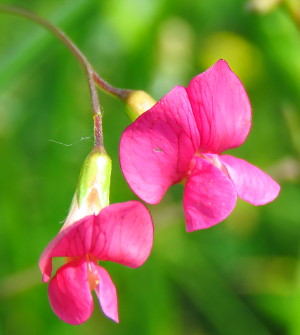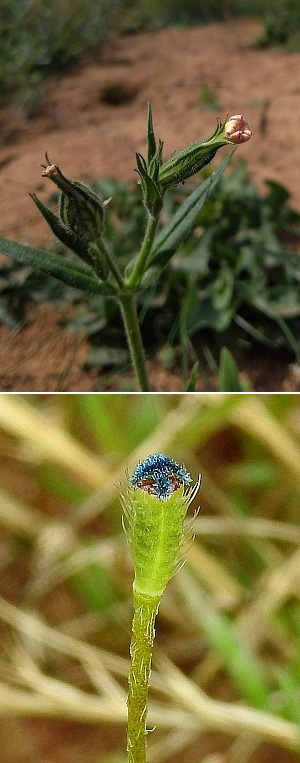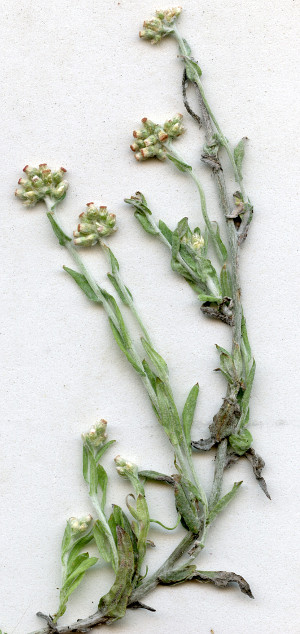Grass Vetchling-
This item is from the website of the Hull Natural History Society, with permission
 Yesterday morning I visited the Argyle Street brownfield site which I know as the KC stadium railway triangle. Before I left, I did a bit of litter picking, and whilst doing this I found a pretty little vetch of unusual colour. I took a photo and used iNaturalist for identification and it came up with Grass Vetchling. At home I looked it up and there were no vc61 records so I doubted this identification.
I met Gabrielle at Argyle Street this morning to show her. She was happy to confirm that it was Lathyrus nissolia, a plant regarded as 'regionally extinct' in the South-east Yorkshire (vc61) Rare Plant Register, 2015 edition.
Yesterday morning I visited the Argyle Street brownfield site which I know as the KC stadium railway triangle. Before I left, I did a bit of litter picking, and whilst doing this I found a pretty little vetch of unusual colour. I took a photo and used iNaturalist for identification and it came up with Grass Vetchling. At home I looked it up and there were no vc61 records so I doubted this identification.
I met Gabrielle at Argyle Street this morning to show her. She was happy to confirm that it was Lathyrus nissolia, a plant regarded as 'regionally extinct' in the South-east Yorkshire (vc61) Rare Plant Register, 2015 edition.
The plants are delicate and very grass-like, with no leaflets or tendrils and the pods are very elongated, with crimson flowers in pairs on long stalks. They are growing on a relatively large patch in the grassland in the middle of the site. How long would this species have been present in the site? We wondered if its grass-like leaves had been overlooked and botanist's visits had not coincided with its flowering season?
Africa Gómez, 12 June 2023
 This dale covers two monads, and has very few plant records. It belongs to Halifax Estates, who gave permission for our survey. We explored the Western side and bottom of the dale in monad SE8253, and found the grassland heavily dominated by Tor-grass Brachypodium pinnatum and lacking diversity (photo). However a large natural spring-fed pond in the far north of the monad supported a good variety of aquatic plants, including Bogbean Menyanthes trifoliata, Marestail Hippuris vulgaris, a Water-Crowfoot, probably Ranunculus aquatilis, Brown Sedge Carex disticha, and Common Spike-rush Eleocharis palustris.
This dale covers two monads, and has very few plant records. It belongs to Halifax Estates, who gave permission for our survey. We explored the Western side and bottom of the dale in monad SE8253, and found the grassland heavily dominated by Tor-grass Brachypodium pinnatum and lacking diversity (photo). However a large natural spring-fed pond in the far north of the monad supported a good variety of aquatic plants, including Bogbean Menyanthes trifoliata, Marestail Hippuris vulgaris, a Water-Crowfoot, probably Ranunculus aquatilis, Brown Sedge Carex disticha, and Common Spike-rush Eleocharis palustris. This large SSSI includes woodland and meadow on both sides of the R Derwent, with the West bank being in vc62. With the permission of the landowner, Mrs Henson, and of Natural England, we attempted a survey of the larger East Bank (vc61) section, and covered the meadows at the southern end and the adjacent wooded slope. We did not reach the area where there is a record of True Fox-sedge Carex vulpina, but John Scott saved the day by bringing his own specimen of this plant from a S Yorks site (photo), and demonstrating the broad, truncate ligule which distinguishes the species from C. otrubae. Kevin Walker from BSBI also joined us, specifically to chase down an old record for Baneberry Actaea spicata, but without success.
This large SSSI includes woodland and meadow on both sides of the R Derwent, with the West bank being in vc62. With the permission of the landowner, Mrs Henson, and of Natural England, we attempted a survey of the larger East Bank (vc61) section, and covered the meadows at the southern end and the adjacent wooded slope. We did not reach the area where there is a record of True Fox-sedge Carex vulpina, but John Scott saved the day by bringing his own specimen of this plant from a S Yorks site (photo), and demonstrating the broad, truncate ligule which distinguishes the species from C. otrubae. Kevin Walker from BSBI also joined us, specifically to chase down an old record for Baneberry Actaea spicata, but without success.  Careful searching of four large sandy fields to the east of the village yielded Night-flowering Catchfly Silene noctiflora (top photo) and Prickly Poppy Roemeria argemone – the latter not easy to see, as the petals had fallen and only the prickly capsule remained (bottom photo), as well as the grasses Squirrel-tail Fescue Vulpia bromoides and Dense Silky-bent Apera interrupta. The Middlewood family, who farm these infertile fields, do so with regard to the flora; they fortunately have another source of income from their tearoom beside the A64 in the village.
Careful searching of four large sandy fields to the east of the village yielded Night-flowering Catchfly Silene noctiflora (top photo) and Prickly Poppy Roemeria argemone – the latter not easy to see, as the petals had fallen and only the prickly capsule remained (bottom photo), as well as the grasses Squirrel-tail Fescue Vulpia bromoides and Dense Silky-bent Apera interrupta. The Middlewood family, who farm these infertile fields, do so with regard to the flora; they fortunately have another source of income from their tearoom beside the A64 in the village.
 With the permission of landowner Mr Ashwin, we surveyed two woods on the estate which had been designated as Local Wildlife Sites on the basis of their ancient woodland flora.
With the permission of landowner Mr Ashwin, we surveyed two woods on the estate which had been designated as Local Wildlife Sites on the basis of their ancient woodland flora.  In October 2023 Dr Africa Gómez discovered a colony of this nationally rare plant growing in Sculcoates, Hull.
In October 2023 Dr Africa Gómez discovered a colony of this nationally rare plant growing in Sculcoates, Hull.
 Yesterday morning I visited the Argyle Street brownfield site which I know as the KC stadium railway triangle. Before I left, I did a bit of litter picking, and whilst doing this I found a pretty little vetch of unusual colour. I took a photo and used iNaturalist for identification and it came up with Grass Vetchling. At home I looked it up and there were no vc61 records so I doubted this identification.
I met Gabrielle at Argyle Street this morning to show her. She was happy to confirm that it was Lathyrus nissolia, a plant regarded as 'regionally extinct' in the South-east Yorkshire (vc61) Rare Plant Register, 2015 edition.
Yesterday morning I visited the Argyle Street brownfield site which I know as the KC stadium railway triangle. Before I left, I did a bit of litter picking, and whilst doing this I found a pretty little vetch of unusual colour. I took a photo and used iNaturalist for identification and it came up with Grass Vetchling. At home I looked it up and there were no vc61 records so I doubted this identification.
I met Gabrielle at Argyle Street this morning to show her. She was happy to confirm that it was Lathyrus nissolia, a plant regarded as 'regionally extinct' in the South-east Yorkshire (vc61) Rare Plant Register, 2015 edition.